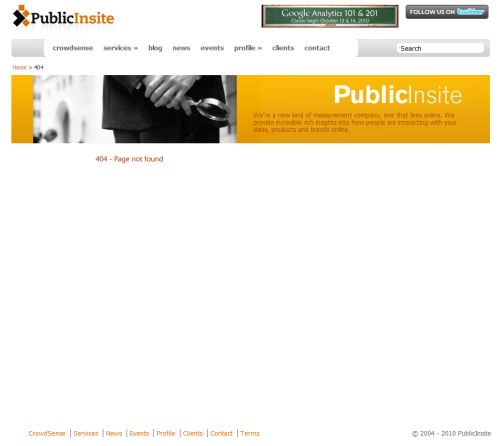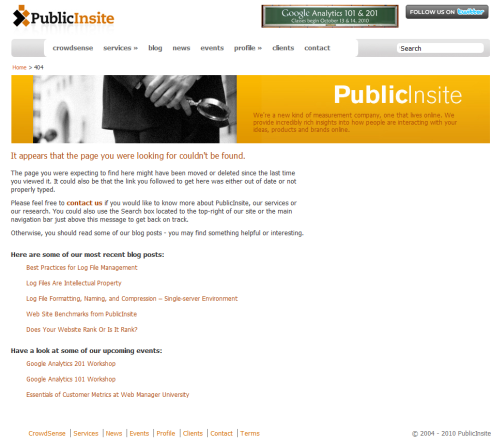Six Tips From the Pros for Your 404 Errors
We get a lot of questions from clients regarding 404 error pages (which judging from the traffic to our previous post about 404 error pages is a very popular topic). To most communications people, mentioning the word “404 error page” gets you a vacant stare, and often this means that not much effort is put into thinking about this seemingly dry, tactical and geeky sounding subject.
But people should care. When a visitor clicks on a link to content, but instead get a page that says “error – page not found”, it has a negative impacts on their perception of the quality of the site and, in turn, the credibility of the organization. Further, if the visitor decides to leave you’ll see erosion of conversion indicators and an increase in your bounce rate. These are all good reasons to share with you a few tips we’ve found that can help you turn this event (which if you manage a large site will definitely happen) from a negative to a positive. The trick is to focus on the key goal: how to keep visitors on your site despite not immediately finding what they were originally looking for. Let’s start with a little review.
What is a 404 error page?
In simple terms, a 404 error page occurs whenever a visitor is able to reach a web site, but the site does not have the specific page the visitor was looking for. In other words, the link finds the site, but not the page. This is a frequent occurrence for sites that have undergone a redesign, or large content rich sites that have had content culled or restructured. In these cases, the web server will return a 404 error, i.e. page not found.
Tip #1: You Must Track Your 404 Page
Knowing what has gone wrong is just as important as keeping your visitor happy, if not more so. The problem is that without some way of monitoring your 404 page, you’ll never know which page or which link caused the 404 error in the first place. Well, there is a way to bend Google Analytics in such a way as to have it report these vital pieces of information to you. My colleague, Scott Shannon, wrote an article about how to track your 404 page that is a perfect companion read to this post (if you haven’t already read his article). The goal of problem-solving is ensuring that a problem does not repeat itself after the specific error and process that caused the problem has been identified. Using the method explained in Scott’s post will allow you to diagnose the problems that your visitors have been encountering and repair the root causes in your site’s web code. Tracking your 404 pages in this manner will also provide you with insight into the intent of your visitors. This information can provide you with great new ideas on future content that are likely to drive more traffic to your site. If a lot of people are looking for pages on ‘how to deal with page errors’ and are consistently finding the address of an old blog post you purged last time you cleaned up your site, maybe it’s about time that you wrote a new, updated post on the same topic.
Tip #2: Make Sure the 404 Page Looks Like it’s From Your Site
Consistent site design is fundamentally important – you want your visitors to know that they’re on the site they’ve been looking for, even if they switch topics or pages in that site. Keeping someone comfortable enough to remain on your site requires continuity and predictability. Landing on an unformatted stark black-and-white default 404 error page breaks that sense of predictability and disorients your visitor. What do we do, as human beings, when we’re disoriented and shocked? We run away. Making sure that the look of your 404 error page is consistent with that of the rest of your site is key to retaining your visitors even in the event of a dead or mistyped link.
Tip #3: Explain the Problem Clearly using Plain English (no jargon!)
What average person knows (or cares) what a ‘404 error’ is? Remember what I said about being disoriented and shocked in the last paragraph? Overly technical code-speak and cryptic explanations explain nothing to the average visitor except that this isn’t what they expected, and that they should go somewhere else. All your visitor wants to know is whether or not they got what they were looking for and how they can find what they’re looking for. Tell the visitor, in the plainest English possible, that the link they followed to get to their desired article might be outdated or that it might have been deleted or moved. Managing expectations in a clear and understandable manner is key to retaining your visitor despite this interruption in an otherwise smooth operation.
Tip #4: Help The Visitor Find What They Were Looking For
I think it’s safe to assume that the only reason most people visit a 404 page is because they couldn’t find what they were looking for. If the visitor can’t find what they’re looking for, you need to help them find what it is that they wanted. Otherwise, they’ll bounce right off your site and onto someone else’s (perhaps a competitor’s site). At a minimum, you should provide a search box or a link to your site map (or both) to help them find what they might have been looking for. This is a little like re-targeting, and will increase your chances of keeping the visitor on the site.
Tip #5: Help Them Find Something More Interesting Than What They Came For
A visitor on a 404 page is someone looking for something. If your site has a particular niche that it fills with its content, chances are that your visitor is interested in a wide variety of things within that category of knowledge. So why not make it obvious and give your temporarily lost visitor something they might want to read? Provide them with links to a list of your recent posts. Provide them with a list of categories. If you run special events which need promoting, provide your visitor with a list of those as well. It is in your best interest (and that of your advertisers) to keep your visitor on the site as long as possible. What better way to do that than to give them something they want to read about! We’ve eaten our dog food on this one: see our before and after 404 error pages. Which one do you prefer?
Before:
After:
Tip #6: Empower the User by Providing a Way to Communicate
From my perspective, when I’m looking for information on the Internet, I’m used to being in control of where I go. I choose what to type into the Google search field, I choose which links to follow and I choose what is or is not relevant to my particular information needs. I can imagine that there are many other individuals out there, accustomed to being able to find what they’re looking for online, who have a similar perception of the way they interact with the Internet. Being stalled in their quest for knowledge, your visitor may become frustrated at their sudden lack of power and control – their ability to find information on their own terms has been compromised. To restore that sense of power and to encourage the visitor to stay on the website, you can provide the visitor with a way of informing you of the error they encountered. A comment box, an e-mail address or even a message that tells the user that the error has been automatically reported can leave the visitor thinking that they’ve made a difference and that they’ve been heard. Managing a person’s perception of their power to change and influence what is going on around them is fundamental.
PublicInsite Web Analytics Inc.














